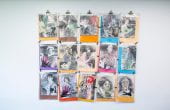Whilst in Venice last week I visited the Proportio exhibition at one of my favourite museums – The Fortuny Museum. The exhibition, curated by Axel Vervoordt and Daniela Ferretti, showed the film ‘Atlanti’ by Francesco Jodice in which one of the characters says ‘It’s not the end of the world…but you can see it from here’.
Somehow the combination of the visit to the Art Biennale alongside the constant news commentary of the refugee and migrant crisis was a painful juxtaposition and reminder of what it is to be human and how our fragile our society and humanity is.
Not only did the exhibition raise all sorts of questions about our individual responsibilities and moral positioning, it also examined the role of the artist, the designer, and the creative institutions in finding ways to provide solutions to help alleviate the individual suffering in this ever deepening crisis.
At LCF we often discuss how we might use the talents of staff and students to address some of the world’s great challenges – poverty, famine, shelter, clothing, climate change – are all conditions where clothing plays a role.
We have done much to highlight the exploitation of resources both human and environmental in the manufacture, production and retailing of clothes through our Better Lives program.
We have touched on the issues of migration- the work of Professor Lucy Orta is a great example- but so far we haven’t really taken on the full implications of a mass exodus, whatever its cause.

Studio Orta: Refuge Wear – Habitent (1992-1993)
UK fashion has always benefited from the influence of immigration from design to production – think of the Jewish influence on London’s textiles industry at the turn of the 20th century – it is an industry that thrives on the positives that new cultures and peoples bring.
However, so far we haven’t really focused on how as an industry or as fashion educators we might find solutions to the very real problems that escaping with just the clothes on your back brings.
The Japanese architect Shigeru Ban, who creates temporary buildings from cardboard to help in the aftermath of other natural disasters is a great example of how creativity can be both beautiful, and of great service to a wider population.

Shigeru Ban’s emergency shelter design used in the response to the 2015 Nepal Earthquake disaster
The artist can do much to make us question ourselves and our motivations and their impact on the world around us – a number of artists at the Biennale created pavilions that did just that – Joan Jonas with ‘They come to us without a word’ and Chiharu Shiota with ‘The Key in the Hand’ are prime examples – but I would like to see fashion students and designers consider what they could design and produce to help refugees or those affected by natural disasters.

Chiharu Shiota: The Key in the Hand
What sort of specially designed clothing packs that are light, easily transportable, able to provide warmth and protection, are well designed and consider cultural or religious needs might be created if fashion puts its collective mind to it?
Our creativity should not been seen in abstract isolation – it has a real life practical application that can and should be employed for use. Ultimately, we are all touched by such crises and if we don’t address them, then all our worlds are under-mined and lessened.

Joan Jonas: They come to us without a word




